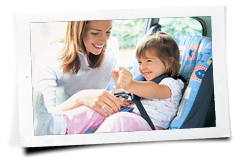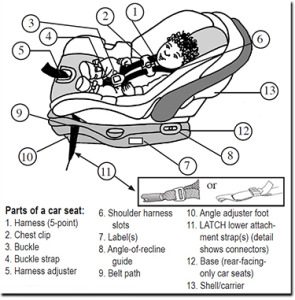 Motor vehicle related accidents are the leading cause of death amongst children every year in the United States. According to the CDC, more than 800 children aged 14 years and younger died in 2011 from motor vehicle crashes, and over 180,000 children were injured. Most of these injuries and deaths could have been prevented.
Motor vehicle related accidents are the leading cause of death amongst children every year in the United States. According to the CDC, more than 800 children aged 14 years and younger died in 2011 from motor vehicle crashes, and over 180,000 children were injured. Most of these injuries and deaths could have been prevented.
The Scary Facts
As a parent, child safety is very important to me and it saddens me to think about how preventable most of these automobile related injuries are. Car seat safety for our children has to be a priority. It is so important that we as parents understand the proper use of a child safety seat. According to safekids.org, approximately 73% of child restraints are misused, 73%!! And of those 73%, infant seats have the highest percentage of misuse, followed by rear-facing convertible seats. Here are a few factoids that should get you thinking (according to safekids.org):
- Booster seats have been shown to reduce the risk of serious injury by 45 percent compared to seat belts alone for children ages 4 to 8 years.
- Children 2 to 5 years of age using safety belts prematurely are four times more likely to suffer a serious head injury in a crash than those restrained in child safety seats or booster seats.
- Child safety seats can reduce fatal injury by up to 71 percent for infants and 54 percent for toddlers (ages 1 to 4).
- From 1975 through 2012, an estimated 10,157 lives were saved by child safety seats or adult seat belts for children ages 4 and under.
- In Maryland, DC, and Virginia state law requires children to be placed in a child restraint until they are at least 8 years old.
 So how do we prevent misuse? First, understanding what kind of child safety restraint your child needs is important. As our children grow they will have different needs for child safety seats; from an infant seat, to a rear-facing seat, then a forward-facing one, and finally a booster seat. Many different kinds of seats exist, so it is important to understand the kind of child safety restraint your child needs.
So how do we prevent misuse? First, understanding what kind of child safety restraint your child needs is important. As our children grow they will have different needs for child safety seats; from an infant seat, to a rear-facing seat, then a forward-facing one, and finally a booster seat. Many different kinds of seats exist, so it is important to understand the kind of child safety restraint your child needs.
A Little Bit About Seats
In order to make the right selection you need to learn a little bit about the options. If you are shopping for a new car seat, you may want to try an app from healthychildren.org. For additional information, Montgomery County has a handy pamphlet that provides a good overview of car seat selection guidelines. Here is a summary for those of us who like the Cliff Notes:
- Rear Facing Car Seats – birth until at least 24 months AND 20 pounds (these are the Montgomery County recommended thresholds, recommendations from some car seat manufacturers may vary), but rear facing car seats are available to support up to 50 pounds.
- Forward Facing Car Seats with Harness – children who are at least 24 months AND 20 pounds, but the important part is the harness must fit the child. These seats can be used with children up to 90 pounds (as long as the harness fits them properly).
- Booster Seat – when your child has outgrown the harness and does not yet fit a seat belt.
- Lap-Shoulder Belt (no car seat) – when your child is at least 8 years of age AND when the lap-shoulder belt fits well (most children will not fit into the lap-shoulder belts without a booster seat until 10 to 12 years of age).
Once you have selected the right car seat category for your child, consider the following suggestions for zeroing in on the right seat:

- Car seats should always be installed in a rear seat.
- Go with a size limit that will accommodate your child as long as possible before you have to replace the seat.
- Always select a 5-point harness if you can (this provides your child with more protection).
- Make sure the harness buckle is easy to fasten and unfasten.
- Use a chest clip, this keeps the straps positioned over the shoulder properly in the event of an accident.
- Use latch connectors when you can as they are usually easier to install correctly, but make sure your car supports this feature (seat belt connections are just as safe, but they can be more difficult to install properly).
- Overall the seat should be easy to use, ie. the straps should be conveniently located and easy to fasten and un-fasten, access channels for lap belts should be big enough for your hand to fit through, and the cover should be removable for easy cleaning (for my son this was really important!).
One mistake commonly made is to use a car seat that was used by a sibling, family member, or friend. Car seats have an expiration date. I was shocked when I learned this, I thought “it is plastic and metal, how can it ‘expire’?”. Two things cause this; first, the car seat will experience wear and tear through normal use. Second, safety regulations change and technology improves over time, so car seat manufacturers place an expiration date (found on the seat itself) onto the seat based on their prediction of when these two factors are likely to occur.
Resources To Make An Informed Selection
Once you have selected your child’s safety restraint, you need to have it installed properly. This doesn’t mean you have to pay a visit to the fire department every time you would like to move the seat from one car to another. You do need to learn how to install your seat properly, however, don’t just wing it. Several resources are available in our area to assist. There is an abundance of resources available locally who can assist, to find an inspection station near you use www.safercar.gov. Montgomery County has a service they offer five days a week, click here to view locations and dates. Most of these services are free of charge and will go out of their way to assist you.
Avoid These Common Installation Mistakes
- Ensure the car seat is installed tightly, the seat should not move more than one inch from side to side or backwards and forwards at the belt path.
- Shoulder straps should be positioned properly. For rear facing seats, the shoulder straps should be threaded through slots at or BELOW your child’s shoulder level. For forward facing seats, the shoulder straps should be threaded through slots at or ABOVE your child’s shoulder level.
- Chest clip should be secured at the same level as your child’s arm pits.
- Straps should be tightly fastened. Most resources refer to the pinch test, where a properly secured harness won’t allow you to pinch any extra material at your child’s shoulders. I prefer to tighten the harness snugly enough where I have trouble getting more than two fingers between the harness and my child.
- Check the belt path to ensure the seat belt or lower anchor strap is routed properly.
- Use the top tether. This adds additional stability to the seat, especially in the event of a forward collision. Not all cars support this feature, so check your owner’s manual.
Conclusion
It is our responsibility to ensure our children are safe. In an area like DC, where we have more people and traffic, the risk of an accident is elevated. A few precautions can greatly reduce the likelihood of an injury, in this case it really is that simple.
Car Seat Laws, Guidelines, and Recall Notifications
https://www.safercar.gov/
https://www.carseat.org/
Videos Showing How To Properly Install A Child Car Seat
https://www.consumerreports.org/cro/video-hub/babies–kids/equipment/installing-infant-car-seats/16845883001/1115046991001/
https://theheartknows.gracobaby.com/install/install.html
https://www.evenflo.com/Learn/Car_Seat_Resources/Basics_of_Installation/Car_Seat_Installation_Videos/
References
https://www.cdc.gov/motorvehiclesafety/child_passenger_safety/cps-factsheet.html
https://www.safekids.org/sites/default/files/documents/skw_motor_vehicle_fact_sheet_september_2014.pdf
https://www.chop.edu/centers-programs/car-seat-safety-kids#.VHzfqdMtBUR
https://www.healthychildren.org/English/Pages/default.aspx
